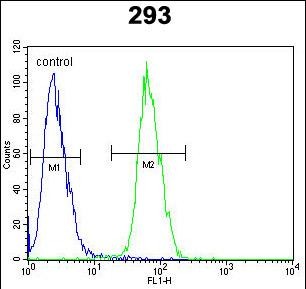PLA2G1B Antibody (C-term)
Affinity Purified Rabbit Polyclonal Antibody (Pab)
- SPECIFICATION
- CITATIONS
- PROTOCOLS
- BACKGROUND

Application
| FC, WB, E |
|---|---|
| Primary Accession | P04054 |
| Reactivity | Human, Mouse |
| Host | Rabbit |
| Clonality | Polyclonal |
| Isotype | Rabbit IgG |
| Calculated MW | 16360 Da |
| Antigen Region | 116-145 aa |
| Gene ID | 5319 |
|---|---|
| Other Names | Phospholipase A2, Group IB phospholipase A2, Phosphatidylcholine 2-acylhydrolase 1B, PLA2G1B, PLA2, PLA2A, PPLA2 |
| Target/Specificity | This PLA2G1B antibody is generated from rabbits immunized with a KLH conjugated synthetic peptide between 116-145 amino acids from the C-terminal region of human PLA2G1B. |
| Dilution | WB~~1:1000 FC~~1:10~50 |
| Format | Purified polyclonal antibody supplied in PBS with 0.09% (W/V) sodium azide. This antibody is purified through a protein A column, followed by peptide affinity purification. |
| Storage | Maintain refrigerated at 2-8°C for up to 2 weeks. For long term storage store at -20°C in small aliquots to prevent freeze-thaw cycles. |
| Precautions | PLA2G1B Antibody (C-term) is for research use only and not for use in diagnostic or therapeutic procedures. |
| Name | PLA2G1B |
|---|---|
| Synonyms | PLA2, PLA2A, PPLA2 |
| Function | Secretory calcium-dependent phospholipase A2 that primarily targets dietary phospholipids in the intestinal tract (PubMed:10681567, PubMed:1420353, PubMed:17603006). Hydrolyzes the ester bond of the fatty acyl group attached at sn-2 position of phospholipids (phospholipase A2 activity) with preference for phosphatidylethanolamines and phosphatidylglycerols over phosphatidylcholines (PubMed:10681567, PubMed:1420353, PubMed:17603006). May play a role in the biosynthesis of N-acyl ethanolamines that regulate energy metabolism and inflammation in the intestinal tract. Hydrolyzes N-acyl phosphatidylethanolamines to N-acyl lysophosphatidylethanolamines, which are further cleaved by a lysophospholipase D to release N-acyl ethanolamines (By similarity). May act in an autocrine and paracrine manner (PubMed:25335547, PubMed:7721806). Upon binding to the PLA2R1 receptor can regulate podocyte survival and glomerular homeostasis (PubMed:25335547). Has anti-helminth activity in a process regulated by gut microbiota. Upon helminth infection of intestinal epithelia, directly affects phosphatidylethanolamine contents in the membrane of helminth larvae, likely controlling an array of phospholipid-mediated cellular processes such as membrane fusion and cell division while providing for better immune recognition, ultimately reducing larvae integrity and infectivity (By similarity). |
| Cellular Location | Secreted. Note=Secreted from pancreatic acinar cells in its inactive form |
| Tissue Location | Selectively expressed in pancreas, lung, liver and kidney. Also detected at lower levels in ovary and testis |
If you have used an Abcepta product and would like to share how it has performed, please click on the "Submit Review" button and provide the requested information. Our staff will examine and post your review and contact you if needed.
If you have any additional inquiries please email technical services at tech@abcepta.com.














 Foundational characteristics of cancer include proliferation, angiogenesis, migration, evasion of apoptosis, and cellular immortality. Find key markers for these cellular processes and antibodies to detect them.
Foundational characteristics of cancer include proliferation, angiogenesis, migration, evasion of apoptosis, and cellular immortality. Find key markers for these cellular processes and antibodies to detect them. The SUMOplot™ Analysis Program predicts and scores sumoylation sites in your protein. SUMOylation is a post-translational modification involved in various cellular processes, such as nuclear-cytosolic transport, transcriptional regulation, apoptosis, protein stability, response to stress, and progression through the cell cycle.
The SUMOplot™ Analysis Program predicts and scores sumoylation sites in your protein. SUMOylation is a post-translational modification involved in various cellular processes, such as nuclear-cytosolic transport, transcriptional regulation, apoptosis, protein stability, response to stress, and progression through the cell cycle. The Autophagy Receptor Motif Plotter predicts and scores autophagy receptor binding sites in your protein. Identifying proteins connected to this pathway is critical to understanding the role of autophagy in physiological as well as pathological processes such as development, differentiation, neurodegenerative diseases, stress, infection, and cancer.
The Autophagy Receptor Motif Plotter predicts and scores autophagy receptor binding sites in your protein. Identifying proteins connected to this pathway is critical to understanding the role of autophagy in physiological as well as pathological processes such as development, differentiation, neurodegenerative diseases, stress, infection, and cancer.




